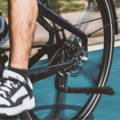Always follow the posted speed limits when riding, staying within your abilities. Electric bikes are heavier than traditional bicycles and can travel much faster in certain conditions, so they require a bit more control. Take it easy to keep yourself and others safe.
Fast & Furious: Top Speed of Electric Bikes
Written by: Rémy Rossi | July 23, 2025 | Time to read 4 min
Speed demon tendencies? Not so fast— top speeds are capped by class, law, and more. Here’s what every rider should know.

More about the Author: Remy Rossi
Rémy Rossi is a bike writer, mechanic, and educator who got his start in community-based bike shops and co-ops. With a decade in the industry, he still wrenches on bikes when he can and plays bike polo on a fixie.

Let’s stop for a moment and talk about speed. How fast can e-Bikes go? Or rather, how fast should they go or are allowed to go? The top speed of an electric bike is an important factor to consider when purchasing your next bike, and can affect where you’re legally allowed to ride it. Here’s all you need to know about the different classes, electric bikes top speeds, and rules to watch out for.
Class type indicates electric bikes top speed

How fast can an electric bike go?
Motor power is different from speed

A common mistake is thinking that higher motor wattage corresponds to higher speeds. While more power can help in certain situations, there are large differences between hub drive motors and mid-drive motors, the latter of which are typically rated at just 250 watts. A 250W mid-drive motor can provide just as much speed as a 750W hub motor— which is limited by the e-Bike class anyway— and typically will deliver smoother power and accelerations. In short, if you’re looking for absolute speed, pay attention to e-Bike class and quality instead of focusing on motor wattage.
Can I make my e-Bike go faster?

But e-Bikes are separated into classes for a reason. Most trails won’t allow assistance or speeds over the 20 mph or 28 mph limits, so “jailbreaking” your bike will likely lead to you riding an illegal bike, probably subject to rules for motorized vehicles like mopeds or motorcycles instead of electric bikes.
Simply put, I don’t recommend trying to make your e-Bike faster and most brands don’t support those tweaks anymore anyway. If you’re struggling with reaching the top speed, try reducing the bike weight, cargo mass, or run smoother tires on paved surfaces.
Laws on electric bikes top speed

Frequently Asked Questions
What is a safe speed for electric bikes?
Do you need a license for an electric bike?
In nearly all states, riders do not need a license to operate an electric bike. However, riders of Class 3 e-Bikes in New Jersey need a license, and e-Bike users in Hawaii will need to pay a $30 registration fee.
Are helmets required when riding an e-Bike?
Helmets are always a good idea when riding any type of bike, and some states require them. Pennsylvania, Massachusetts, and Oregon are some of the states that require wearing a helmet when riding an e-Bike, though most states don’t have a legal requirement.
Key Takeaways
- E-Bike class determines max speed: Class 1 & 2 top out at 20 mph; Class 3 reaches 28 mph with pedal assist only.
- Motor wattage ≠ top speed: A 250W mid-drive can match a 750W hub in speed—what matters most is the bike’s class and motor quality.
- Modding your e-Bike may make it illegal: Unlocking speed limits can turn your e-Bike into a motor vehicle under the law.


